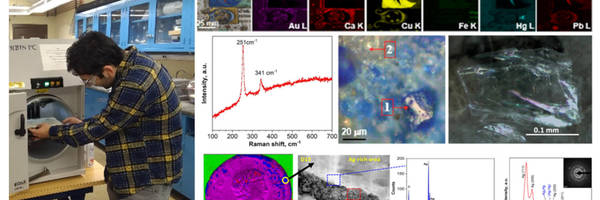
Exploring Cultural Heritage
With a highly interactive and extensive collaboration between the Nuclear Science Laboratory, Hesburgh Libraries, Department of History, Department of Chemistry, and Snite Museum of Arts at Notre Dame, we are developing new analytic methods for revealing the composition of pigments in medieval European manuscripts, Roman, Spanish, and British Colonial coins, and paper money printed in American Colonial and Confederate periods. These studies enjoy a high level of undergraduate engagement and are crucial for liberal art communities while providing a unique opportunity for non-physics students with new insights, understanding, and appreciation of the scientific method through hands-on participation. The program has incorporated more than fifteen undergraduate students so far, from various disciplines, in generating their first scientific publications. Besides physics and chemistry, students from art history and conservation, classics, and medieval history from Notre Dame and other institutions have participated.
- K.V. Manukyan, M. Raddell*, E. Sestak*, D.T. Gura, Z.D. Schultz, and M. Wiescher, Pigment and Ink Analysis of Medieval Books through Complementary Spectroscopy Techniques (Opinion), Global Journal of Archaeology & Anthropology, 3(4): 555619 (2018)
- K.V. Manukyan, C. Fasano*, A. Majumdar, G.F. Peaslee, M. Raddell*, E. Stech, M. Wiescher, Surface Manipulation Techniques of Roman Denarii, Applied Surface Science, Applied Surface Science 493, 818-828 (2019)
- K.V. Manukyan, B.J. Guerin*, E.J. Stech, A. Aprahamian, M. Wiescher, D.T. Gura, Z.D. Schultz, Multiscale X-ray Fluorescence Mapping Complemented by Raman Spectroscopy for Pigment Analysis of a 15th Century Breton Manuscript, Analytical Methods, 8, 7696-7701 (2016)
The characterization of cultural heritage objects becomes increasingly essential for conservation, restoration, dating, and authentication purposes. The use of scientific methods in archaeometry and conservation science has led to a significant broadening of the field. However, scientific analysis of these objects is challenging due to their complex composition, artistic and historical values, which require minimally invasive and nondestructive analytical procedures. We utilize various accelerator (PIXE) and non-accelerator (XRF, Raman spectroscopy, x-ray diffraction, scanning, and transmission electron microscopy) based techniques to investigate the cultural heritage objects and historical artifacts.